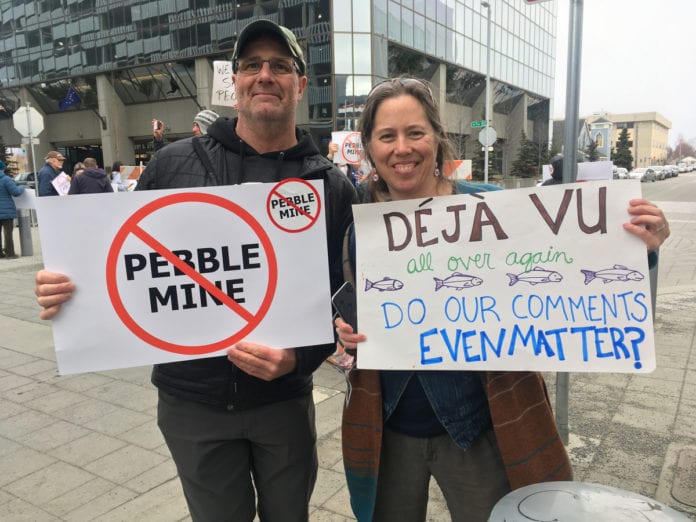
Several hundred people turned out on April 16 for the final public hearing on the U.S. Army Corps of Engineer’s draft environmental impact statement on the proposed Pebble mine in Southwest Alaska, both to protest and to support the project.
Along with those who came to testify were many others who gathered for a rally outside the hearing to protest the mine.
The deadline to comment is May 30, and the USACE has not said whether it will extend that deadline, which many have said is needed so more people can comment on gaps in that DEIS.
“We want a 270-day comment period,” said Gayla Hoseth, second chief of the Curyung Tribal Council in Dillingham and director of natural resources for the Bristol Bay Native Association.

That extension of the current 90-day comment period is needed so people can comment on a mine that will have irreplaceable impacts on people, wildlife and the environment, Hoseth told the corps at the Dena’ina Center in downtown Anchorage.
Hoseth and a number of others who testified criticized the content of the DEIS and what it did not include, including discussion of how such a mine would impact community health, Native cultures and the lifestyles of area residents.
“People are already suffering from the mental stress of trying to protect Bristol Bay,” Hoseth said. “The mental stress will only increase if this mine is built.”
“Since 2009, Bristol Bay Native Corp. has been in opposition to the mine,” said Joseph Chythlook, of the BBNC board of directors. “We remain opposed to it. We have been to every meeting we can attend to oppose it.”
“The EIS process is too fast. We need to slow it down and allow more people to study it and see what effects it will have. There is an overwhelming majority of Bristol Bay residents and Alaskans who have opposed the mine. I hope you have listened to them,” he told the corps.
Chythlook also admonished the corps to take seriously the comments of residents of small villages in the Bristol Bay region “and not just treat their comments as anecdotal information.
“I hope you will listen to them,” he said. “We want to keep that land forever as it has always been.”

Others speaking in defense of the McNeil River State Game Sanctuary, the largest gathering place of brown bears in the world, said development of the mine would have an adverse impact on the bears.
“Every mining operation probably has a plan that will not work, despite the best intentions,” Wayne Rush said. “Why put this neat world renown bear viewing area and fishery at risk because of the mine? Let’s not risk it. Let’s not put this mine there, where something bad could happen and damage the environment.”
Taryn Kiekow Heimer, speaking for the Natural Resources Defense Council, brought up tailings dams that failed over the last five years alone across Brazil and Canada, killing hundreds of people and leaving a dead zone of polluted water.
The DEIS, said Heimer, “fails to meet basic requirements of the National Environmental Policy Act and the Clean Water Act by fast-tracking the permitting process, underestimating the long-term risks to people, water, wildlife and fish; by discounting Pebble’s unprecedented water treatment plan, and by ignoring impacts associated with fully developing the Pebble mine, including the mining district in Bristol Bay that Pebble would ignite.”
Heimer said the biggest question that the DEIS fails to ask is whether Pebble’s mine plan is economically feasible.
The mine drew full support from the Alaska Miners Association, the Resource Development Council, and the Alaska Policy Forum, who said the mine would provide well-paying yearround jobs to boost the region and state’s economy.
“I’m back on government help,” said Clyde Trefon of Nondalton. “We need these (mining) jobs”
Henry Olympic, a commercial fisherman and president of the Newhalen Tribal Council, said that BBNC did not speak for them.
“We cannot live off fishing. We need jobs,” he said. “A lot of people have sold their permits. We’re not going to get all this money for welfare.”
But Peter Andrew Jr., a veteran Bristol Bay fisherman and longtime opponent of the mine, said that BBNC had done the analysis and their shareholders overwhelmingly opposed the mine.
“I am also a fisherman,” he said, “and commercial fishing had put all four of my children through college.”














